
As an artist and a designer I have been involved in blogging and social media for many years. I coach creative individuals and businesses in how to use social media, and Instagram is the platform I recommend most. I have found that many artists, particularly older ones, remain on the sidelines unsure if the distraction will be worth the effort and time. Although 60% of Instagram users are between 18-24, the percentages drop to 18% for 50-64 year olds, and only 8% of those over 65 use the app. Given that many artists reach maturity and do their best work at well over 50, this is a startling waste of one of the best marketing platforms available to artists today.
There is a common perception that Instagram is a shallow and narcissistic platform devoted to selfies, lifestyle, and Beyonce’s latest platinum baby bump. (True!) But dig deeper and type a few key hashtags into Instagram search: #abstractart (10.3 million posts) or #artgallery (9.3 million) or #painting (56.5 million). There are serious followers of art online: 79% of art buyers under 35 years old use Instagram to search for new artists. According to the Hiscox report 4 in 10 art buyers bought online in the last 12 months, in a market valued at an estimated 4.22 billion. If you are aware that the older generation of art collectors is, um – dying? – these statistics might get your attention.
The two basic strategies of social media for creatives
When I first started looking at Instagram I had my own doubts. I was dazzled by the caliber of art illuminated on my phone, and overwhelmed by the quantity. Was it true that Instagram could “make” your career? What if nobody followed you? Did you have to be young, beautiful, rich or pierced in strange places? Could you be a quiet introvert? I watched from afar for a long time, trying to understand what made this platform work.
In studying a wide spectrum of artists and creatives it became clear to me that Instagram, like other social media, follows two main strategies, paths that I call Audience and Witness.
The path of Audience is driven by entertainment value and puts the viewer in the driver’s seat: it aims to please. If you are following the strategies of Audience you respond to what the audience likes by doing more of it, and giving them what they want. “You,” in a sense, follow “them.” The path of Witness is related but different. Yes, there are viewers, but they are secondary to you, the maker. The viewers are there to fall in love with your journey, to learn from and to be present to you. They are your peers and your community. They truly are following you and not the other way around.
In social media both paths are important. Witness and Audience intersect in many places, and each has elements of the other. But it is important to know the difference between them and to know what you are doing when you are doing it. This article is an in-depth look at the important principles behind social media marketing for artists, with a roadmap for how to use them, specifically on Instagram. First, a look at a popular buzzword.
What does it mean for an artist to have an Instagram “brand?”
It’s a doctrine of social media marketing that you need to be on Instagram to build and promote your “brand.” An online industry has spring up to teach you how to harvest attention, get followers and (theoretically) Sell Your Work and Become Famous. “Branding” is a word that has evolved in popular usage far from its origins in Madison Avenue. It is often equated with “logo” or “identity” in terms of a unique identifying trademark. But its original meaning as used in 1960’s advertising is more complex. David Ogilvy’s famous definition is “The intangible sum of a product’s attributes.” In other words, what you say, how you say it, and what people associate with you. More than a recognizable symbol or name, it is how you are perceived. How does this translate into the highly visual platform of Instagram?
When people say you should have a “brand” on Instagram they often mean you should choose and adhere to a rigid formula of consistent composition, color and content. An unfortunate truth of the internet is that curation wins. In a world of billions of images the brutal war for attention rewards the person who can arrange a collection of pleasing, similar and colorful images in coherent order. If you ignore this completely in favor of anarchy, or a misguided idea of authenticity, attracting followers will be much harder. If you are an artist trying to attract collectors to your work, think very carefully about how you tell the story of your art, and how that story will attract the supporters you want.
The most basic rule of curation is very simple: get an Instagram business account. If you want potential galleries, buyers and the last two art critics in America to see your work, label the account clearly with your own name, and keep the focus on your art: you want people to find you, right? “CadRed” won’t cut it for your name, unless you are very famous, – and famous for being obscure – already. Once you get a business account you will have access to invaluable statistics on who your followers are, where they are from, and how they arrive at your images. You can also automatically link your Instagram posts to your Facebook business or personal page so your posts appear in both places.

Now you are ready to set up a profile and add your artist websites. Instagram limits your profile to one live link, but by using the app Link Tree you can add more than one website to your bio. Go to Instagram’s simple tutorial for how to upload photos from your phone. If you want to upload from your computer it is a little tricky, but one way can be found here. A tutorial on new alternate methods can be found at Softwarehow.
Back to the first step in finding an audience, eyecandy. Here are some suggestions for consistency and strategic interruptions, ie. the DNA of your visual brand:
Squares or rectangles?
Although the predominant format of Instagram is square, it now allows for rectangular posts. If you click on the little icon in the lower left hand corner of your initial image, your post will appear in nearly full frame, though it will be cropped to square in the IG search functions and home page.
Pick one format, and stick with it. The overall harmony of a page relies on repetition and consistency. I tried originally to mix the two, and trust me, it’s a mess. (There are exceptions to this rule of course, but to do this successfully another element like color or value needs to tie your page together.) The advantage of composing in a square is that it gives the most real estate to your image and insta-order. The drawback is that your artwork may not always be square, and your post may not convey a sense of the overall composition of your art. You can beat this by using the multiple page post function. Attract views with a striking cropped image, followed by the zoomed out full view (or additional cropped close-ups) in subsequent pages.
Should you have a color theme as part of your brand?
There are many ways to standardize your color tones on Instagram so that everything on your page looks like part of a seamless whole.
Tech tip 1: You can achieve harmony through the Instagram filters themselves, or through using an app like VSCO or Snapseed, which offer more options and more sophisticated fine tuning.
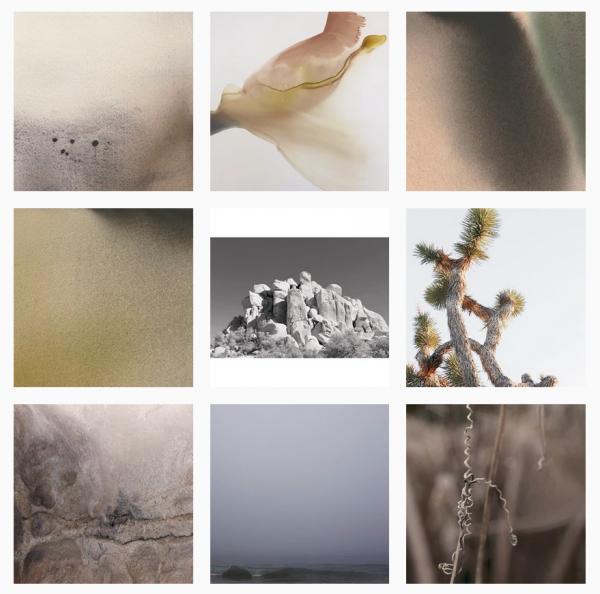
The problem with standardizing your color if you are an artist is that your work probably is not “standard.” It has its particular color, and that should be as accurate as possible, particularly if you want collectors to purchase your work online and not be disappointed. If the main emphasis of your art practice is commissioned art for interiors, and your art has a consistent palette, you may want to choose a color theme and stay with it throughout your postings. It can also be effective to make calculated deviations that clearly distinguish images of your art from images of your studio, self portraits or events like openings. One easy way is to use a black and white filter or a limited palette for anything that is not your artwork.
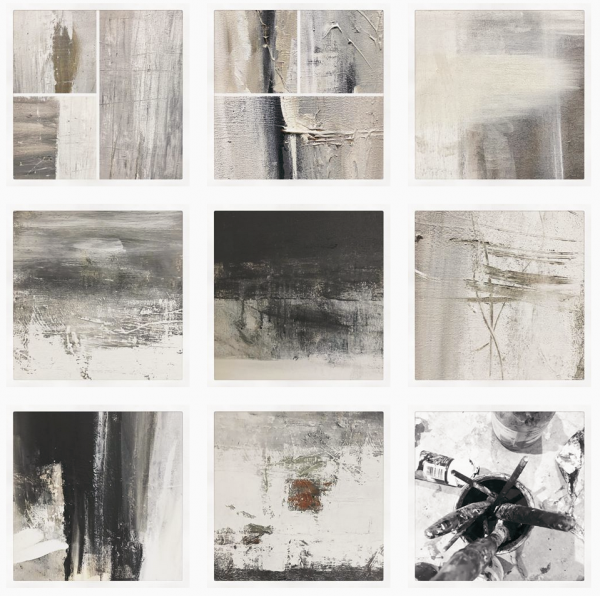
Tech tip 2: One of the best ways to experiment with layout and color options is in the app Preview for Instagram. It’s a deep app with lots to explore so I won’t go into it in detail here. By using Preview you can plan how the color balance of your feed will work, and schedule your posts days ahead. If it looks like rocket science, you can be sure it’s an app.
“Brand” is not just a visual effect. It is also a point of view. Although the principle of visual consistency rules, authentic anarchy gives it a run for its money. People are hungry for the real. And if you were wondering about my original doubts about who gets to play, no, you don’t have to be 23, model-pretty, blond, obviously tattooed, fashion-forward or blue-chip-famous to win here. One of my favorite artists on Instagram is Carl Heyward of the Global Art Project.
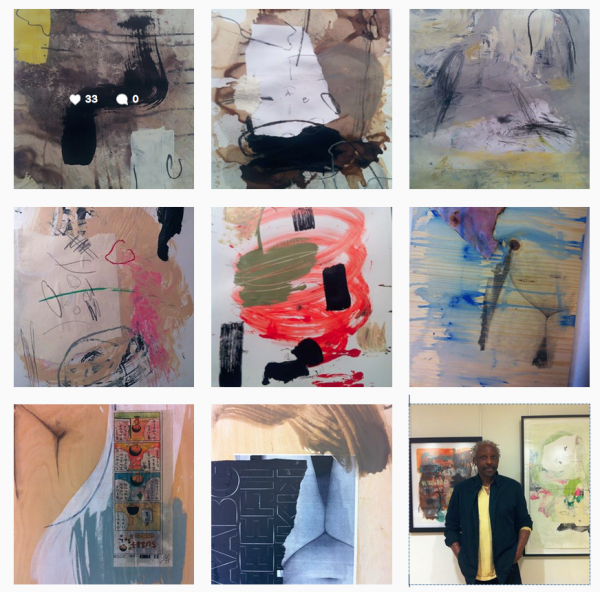
Ok, maybe he is actually fashion-forward. The Global Art Project premiered in Venice and offers workshops around the world. Check out Carl’s Instagram to follow his stream of vivid and spontaneous abstraction.
A completely different take comes from Polish artist Izabela Kita:
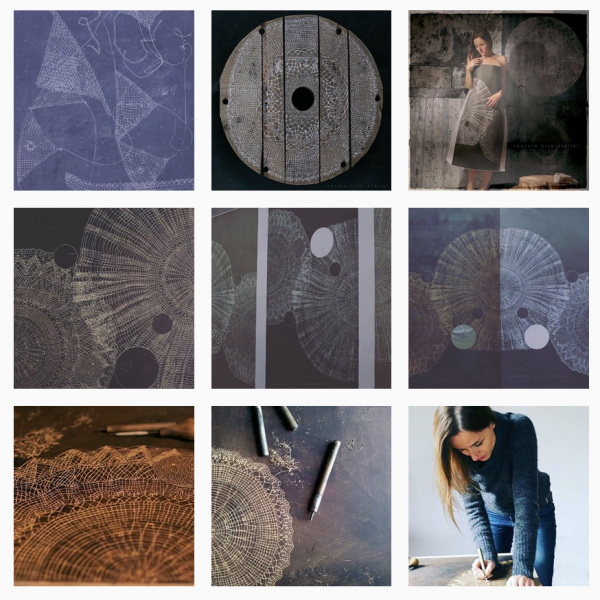
These looks are very different, and yet each succeeds in creating a mood, a voice and an ambiance that is indelibly “branded” in its association with the artist, integrating a portrait of the person and the work in just the right way.
In terms of the Audience/Witness continuum, today’s internet audience does want to see you. If you are an introvert, or not photogenic, this can be a challenge. I am personally a cameraphobe. I have always assumed I look like my avatar, Ozma of Oz,* (See Post Script) who is perpetually 17 and has long tumbling curls and an emerald on her forehead. Alas the camera refuses to capture that and instead I endure the humiliation of being an ordinary person who looks uncomfortable and didn’t get the right nose. This is life. Go with a blur filter, make videos that mostly show your hands, or narrate your daily path to the studio with a video that focuses on your splattered tennis shoes. Work up to eye contact….Showing your face makes a direct human connection with audience in the most basic way, and brings people directly into your life in the studio. There is always a way to show yourself that feels right, and I urge you to take it on as a creative challenge.
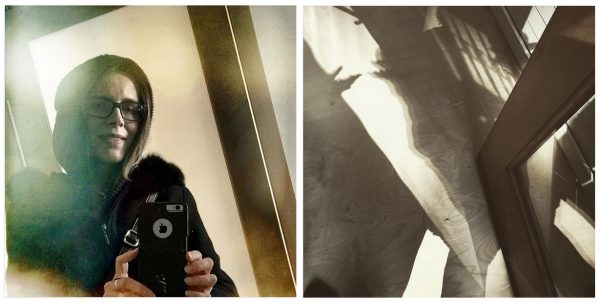
Tech tip 3: Instagram Story If you are unsure you want your face to stay on the internet for more than a minute try using Instagram Story. Stories are usually meant to have a very short life span of hours or a day. You can experiment, and if you don’t like it, delete it without interfering with your Instagram feed. You can also use Story to veer off brand if you just can’t help sharing videos that have nothing to do with your studio life or inspiration. I use Story as a laboratory. Sometimes I tie my story into a recent post, sometimes I link from a post to a story, sometimes I go completely rogue, and show videos of the wind. (Slow videos of wind, which exhaust my audience after about three seconds.) Story has a deep interface that can be used to great effect with creative uses of type and motion. It can be an ideal platform to show the evolution of a body of work, with images interspersed with type, voice-over, inspiration and process. Tutorial here.
How to Use Hashtags
On a global platform with 95 million images per day how do you get the attention of the people who are most interested in your work?
Tech tip 4: Hashtags. And no, hashtags are not “Cheating.” By using a word or phrase with the #sign in front of it you signify to people the contents or stream in which your content fits. There is an art and a science to using hashtags. You want to choose categories that are well populated by similar content to yours, yet you don’t want to get lost in a category so large and general that you will never be found.
As with so much of social media marketing it’s a matter of constant research. Go to Instagram search and explore – and keep careful notes. Try out tags that seem to fit your work and see what kinds of images come up. Look at what artists you admire are using. And consider creating your own tags that allow your work to come up as a set. This might be as simple as #yourname or very particular and customized to a body of work. Picasso had his #blueperiod, and you can have yours. Perhaps with an uncommon twist, like #Verditer (a phenomenal Daniel Smith blue for which there are not yet any posts.)
To avoid looking calculated or spammy, carefully work out your hash tag list (up to 30 per post) and type them into an app like Notes on your phone that allows you to press return. Typing five or six periods with a return after each will allow the hashtags to remain invisible on first glance when you copy and paste them in the first comment below your post. If you have converted your account to a business account as I advised you will be able to see if your hashtags are reaching the people you want. A caution: do not blindly copy and paste the same list of hashtags on every post, and do not throw in irrelevant popular tags just to get views, as this can potentially cause Instagram to shadowban you. Keep track of your lists and what works, and be ready to improvise.
The Instagram Giveaway
You might think that by showing your artwork to the world on a daily basis you were “giving something away” already and that should be enough. But keep in mind, you are also asking for attention. In return for that, Audience often wants more: the actual #giveaway. This is a tried and true method of gaining followers and (highly conditional) loyalty. Some painters give away prints of their work, others give away small paintings, and many offer video tutorials that make impossibly virtuoso technique look easy.
In return, the artist makes an ask: follow me, tag a friend, make a comment. This is a technique that quickly builds community, and increases your followers, although it is up to you if this is the community you want. It may be appropriate for an artist without a gallery who plans to build their entire career online, or for an artist who bases much of her income on teaching classes, but for an established artist who makes a living from gallery sales or grants and university teaching it may not set the right tone.
Witness: Finding Your Tribe
Above I have outlined some of the main strategies of gaining Audience. Witness is less obvious. Witness is about finding your tribe, your peers, and the people who will follow you on your path even if it radically changes course. Witness is where marketing and authenticity meet. You use the platform lightly, without allowing the rules of consistency to rule you. You design your Instagram to allow for a branding architecture with missing planks that allows for changes as you develop as an artist. You share your work, your life and your point of view in such a way that your viewers trust that you are real, and they want to know where you go next. Witness can lead to mentorship, friendship, shows, sales and a sense of communion that balances the isolation of life in the studio.
So how do you do that? And can you do both?
One way to find Witness is to take risks. One of my favorite artists is Paul Brigham, who I first met through his paintings of birds. When I started following him on Instagram his work was familiar to what I had seen in galleries. And then there was a change, as he began painting increasingly abstractly. He brought his audience along with him, in the “safe space” of freedom and improvisation he created between himself and his followers:

You can see a mature artist’s development through these progressions, and it creates a powerful engagement with his followers. It is not unusual for Paul to have 400+ likes and a dozen comments on a post.
Painter Adam Miguel Estevez shows his photographic inspiration, and his Instagram is more of a personal dialog with his own process, with an occasional glimpse of finished work or publications. He establishes legitimacy by revealing how he sees the world around him and connects it with painting. He has told me he uses Instagram primarily as a way for him to witness his own path, and I feel when I drop into his feed like I am intimately seeing through another artist’s eyes.
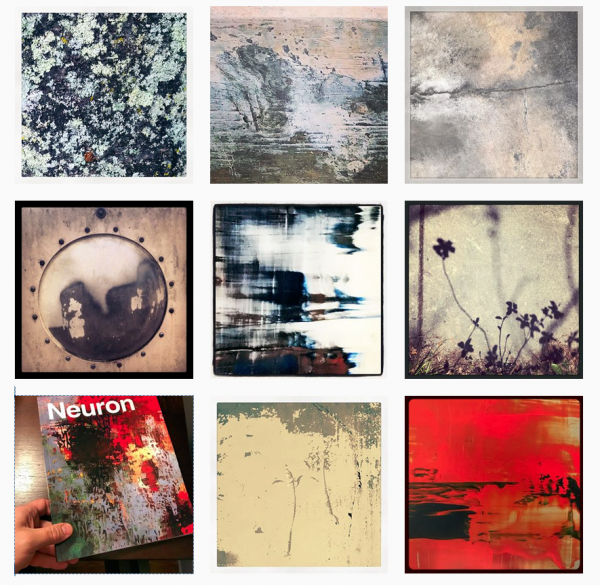
Self-witness is a very powerful side-effect of Instagram. When you view your work shrunk to a 2” square on the phone the change in scale will quickly reveal flaws in composition or value. Seen in the flow of other artists’ images you may understand your work more clearly in terms of quality or concept, or where it fits in curatorial terms. I sometimes post work at the quiet hour of 2 AM just for this perspective. And more often than not I delete it minutes later. Self-witness doesn’t always need to be shared with the whole world. Search #thedeletedepiphany (it’s empty….)
The #30daychallenge
Instagram offers another way to take risks with the support of a built-in community: the #_daychallenge. This is usually 30 or 100 days and can be customized to a particular theme or media. The #30daydrawingchallenge has over 45,000 posts from people who have participated. If you attach this kind of hashtag to your series you will find that other people participating will immediately be able to find you, and it can generate a huge following of like-minded peers as well as fans who simply like to see what happens when someone has the discipline and courage to make something everyday and share it with the world. This approach is taken by beginners but also by seasoned artists, who may want the encouragement of peer approval and the accountability that comes with publicly promising the world you will do something.
Tracey Adams is a Bay Area artist of considerable renown, recipient of the Pollock-Krasner Foundation Grant and represented in many galleries and museum collections. In “A Line’s Story” she recounts how the 30-day drawing project fundamentally affected her art process as she worked through the loss of her mother.
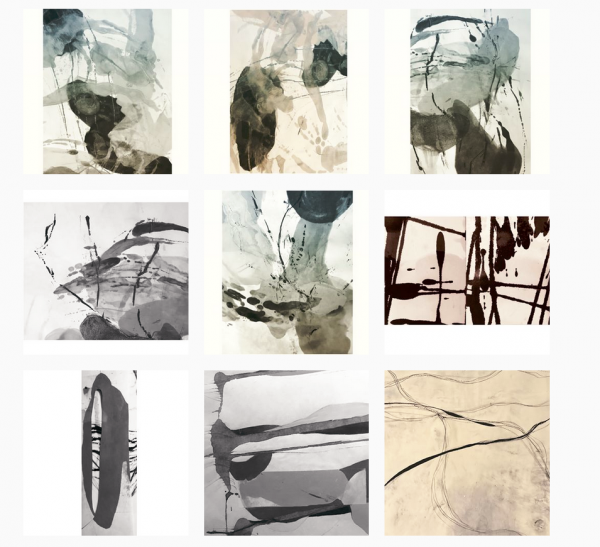
Designer and Illustrator Leslie Newman devised #100daysofshapemaking to launch herself into a completely new form of creativity, committing each night to a new abstract composition on her ipad. The intense focus of a 100-day project can accelerate learning and propel an artist into a new zone very quickly. With the encouragement of her followers and the exposure to other artists and curators on Instagram, Leslie was invited to exhibit her work in a group, which led to her first solo show.

Established structures like the #days bring together witness and audience. The process (ideally) is one of authentic vulnerability and learning in public. It can tie your page together visually with a consistent theme and bring you both patrons and new fans.
Consider the Word
In the beginning Instagram was positioned as a nonverbal platform, an antidote to the busy oversharing and addictive comment threads of Facebook. As I began to follow a variety of accounts I noticed that some people used their posts for lengthy stories and inspirational advice to others. The comments became in-depth conversations, often spurred by a question posed to followers. As a cross-disciplinary artist this gave me heart. Now my posts may be captioned with experimental stories, random acts of haiku and non sequiturs. Usually the words are in dialog with the images (even if that may not be obvious to anyone but me.)
Instagram can also be an excellent place to pose a question and receive expertise from the hive and assorted authority figures: Where do you get float frames for thin wood panels? What varnish brush do you use? Or, if you are Jerry Saltz “HAs an aRt DEALER or a collector Ever NOT paid you, TAKen your work, etc., etc? What happened? NaMe naMes. OR NOt.” (1,336 answers.)
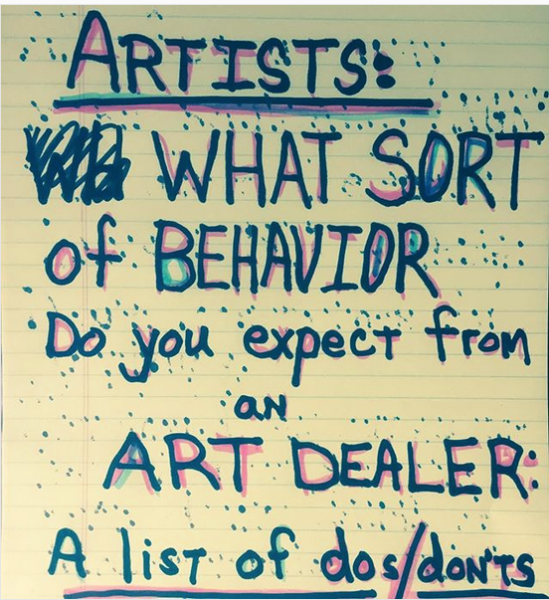
Actual words can be a very good vehicle for finding your visual voice and getting an attitude, if you don’t have one already.
Don’t Diss Your Fellow Artists
Most artists quickly find that their first followers are, (hiss) other artists or art students, not “collectors.” But don’t forget that plenty of artists:
a) collect art
b) have a day job
c) are married to a person with a day job
d) have houses (where their collector friends may see your work)
e) have galleries (and make referrals to their gallerist)
f) curate shows (and are always looking for peers to show with)
g) have collectors who pay attention to what artists collect.
Artists are your friends. And students of artists are some of the biggest buyers of their teachers’ work. In my own case about 30% of the serious collectors of my work are also artists, or fellow creatives in another field, like writing or architecture. At least half of my shows have happened due to other artists seeing my work online and recommending me to a curator or gallery.
Your community of artists is a place where Witness and Audience most definitely cross over. If you are authentic and reveal your process and the heart of your work you will attract other people trying to do that, and who admire that. They may well become collectors. Perhaps more importantly they will become your tribe, and that is a prize. I follow people all over the world who have opened my eyes to new ways of seeing. Without Instagram I would never know about Michelle Fletcher, who leads artist workshops in Morocco or Axel Bergk in Germany, digital master of worlds beyond time and space. Or Kaj Ard from Helsinki who paints with fire. Or Rait Gainullin of Yaroslavl, a true genius of calligraphy and guitar (you’ll find them both.) Closer in Chicago, Louise Le Bourgeois. Her dreamscape water painting and her writing make me want to be better at everything I do.
But wait, I just want to sell my stuff. Enough with the hearts.
I know. Everybody wants to sell their stuff. What I can tell you is that you might get lucky. And that “going viral” and getting Marc Jacobs to follow you and buy a painting is not that easy. 10,000 followers is no guarantee of a single sale. It certainly doesn’t hurt to have a lot of followers, but you need genuine ones, not bots and not ones bought with bots. Instagram is one of many tools that builds your presence and credibility in the art world. It’s a long game.
There are, of course, people selling stuff, and although selling is a book into itself here are a few tips:
Consistency. Post the same damn thing or something that looks almost like the last thing, again and again. This inspires trust. Use the same image format (a painting, a brush, a brush, a painting) so your grid looks. . . like a grid.
Keep your price point low. Tie into Etsy, Shopify or Big Cartel, and make it easy for people to click through to your shop.
Post your prices clearly.
Give stuff away.
Be kind to your followers.
Start low and trust that your first time buyer will eventually buy something big.
Consider that you don’t have to be perfect, or established, or better than the next person, to have someone fall in love with your work.
And back to hearts, do focus on the love. #communityovercompetition is a hot hashtag for a good reason. Social media is built on appreciation and sharing, and that will take you far.
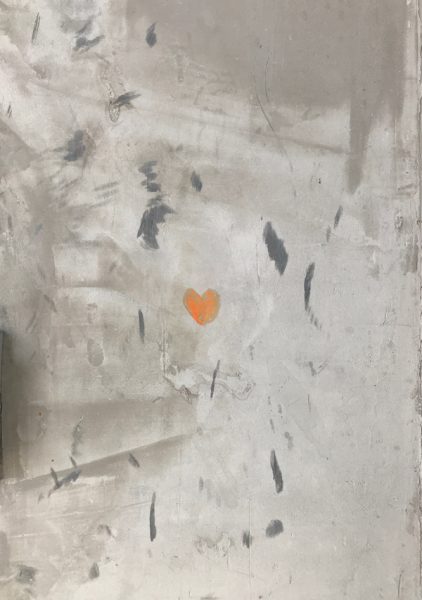
If you would like to learn more about social media for creative businesses, I am offering a workshop at the Seattle Artist League September 8th. Social Media for Artists: Finding Your Authentic Voice. Please contact me directly if you would like to work with me for one on one coaching. And if you would like to follow my social media experiments (that would be my own Instagram,) check it out!
I welcome your comments below. What has worked for you on instagram? What’s your biggest success story? What drives you crazy? I’d love to hear from you! (And feel free to ‘like’ and share this post.)
Text © Iskra Johnson.
Psssst: It’s come to my attention that exactly NO ONE knows about Ozma of Oz, which is a tragic loss of cultural literacy. Am I the only child who read beyond the Wizard to all the Books of Wonder? Ozma rules. She is the Princess of Oz. Here she is in all her glory, from the battered first edition that is my most prized possession. Those are emeralds in her hair. According to her the Wizard actually created the Internet.

Kathy Elliott says
Iskra!
Wow, this is the best info I have seen about Instagram anywhere….. and you are giving it away…. you are amazing. As an artist, a writer, a person, a source info on so many topics.
Thank you so much!
I am a forever fan of your work and your words.
Kathy
Iskra says
Thanks so much Kathy!
Iskra says
Thanks so much Kathy!
Julie Blasberg-King says
Wow, this is simply the best information about using Instagram for artists; thank you Iskra. I am over the pond, so not able to attend a workshop on this, but can I suggest offering one online? I would be interested in this format and I’m sure others would too.
Julie
Iskra says
Hi Julie,
Thank you for that suggestion. Right now I am really enjoying working with people face to face in classrooms and one on one. There are a lot of technical aspects (and developer expenses) in offering a course online but I will keep your suggestion in mind.
Leslie Newman says
I echo the Wow! This post is super thorough and helpful, thank you! (And thanks for including me 🙂
I guess I better switch to a business profile. I’ve hesitated because of the worry about Facebook changing the rules and making “businesses” pay to be visible on Instagram.
I recently did a giveaway. It was a lot of work but was fun for me. It was a way to mark the completion of my second 100-day project.
All the best!
Leslie
Diane ponder says
Having everything a single tied in color? Not sure depends on who’s your target interest demographic
Iskra says
Diane, for artists geared towards working with interior designers and doing commissions a limited and predictable palette can be a very effective presentation. It looks harmonious as an overall grid in Instagram, and also suggests that the artist can repeat something reliably, a key element to finding (and keeping) commission clients.
Brian O’Neill says
Ozma rules and so do you. But wait, you’re one in the same! Thank you for your articulate, inspired and much needed essay.
Melinda says
Iskra,
Thank you for such a generous post. I’m continuing to take baby steps. I am currently doing a “promotion “ and it has increased my numbers significantly. I have no idea about the “quality” of the followers, but the numbers are nice.
Thank you again….
❤️ Melinda